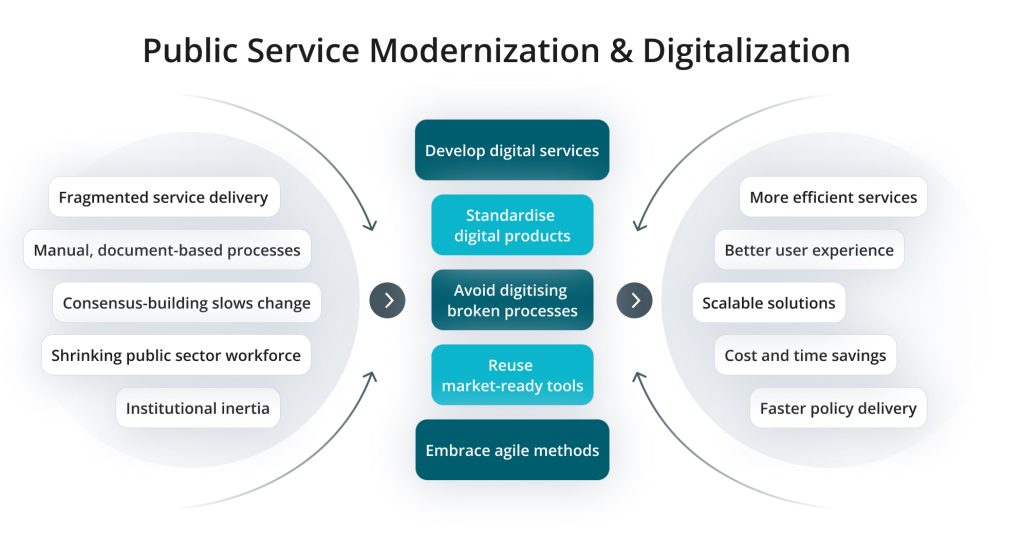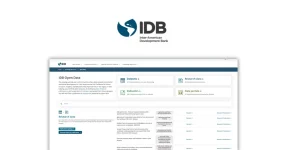The idea of a Creative Bureaucracy Festival may sound like a contradiction in terms, but the intent behind the day-long event in Berlin in early June makes complete sense: to create space for public administrators to discuss how to work smarter and, particularly, to ramp up their use of data and digital to provide more innovative, efficient, and better services.
The Festival, the eighth to take place so far, brought together public administrators from Germany and across Europe, and as far afield as Australia, New Zealand and the United States, along representatives from universities and other large public sector bodies.
Understandably, much of the meat of the event took place in the large German language component of the program. But, for non-German language speakers, there were still plenty of sessions to attend. Those I attended offered up several common themes, foremost being the massive pressures facing European governments to improve data and digital driven services.

Public administration and the polycrisis
The theme that most tied the day-long event together for me was the challenges facing the public sector and those working for it, from what several conference speakers referred to as a time of polycrisis. First used in a 1993 book by French philosopher and sociologist Edgar Morin, the term has become an increasingly popular shorthand to describe not just the existence of multiple major crises but how these interact and reinforce each other: climate change, war, economic instability and poverty, and growing transnational migration.
One of the most obvious manifestations of the polycrisis at present is the second Trump Presidency. An administration intent on pulling back from productive engagement abroad, while rapidly dismantling public administration at home. “Polycrisis is not the word for what is happening in the US government right now,” stated one American public servant at the event. “It’s just crisis and chaos.” The challenges of being a public servant amid the dismantling of public administration, including much of America’s science and research capacity, and the wholesale removal of vast swathes of government data, have been analysed at length in the media. Less commented on is the fact that the Trump administration’s actions have trickled down to state and even local governments, causing widespread public administration paralysis.
The rise of what might be termed anti-government governments is also occurring outside of the US, for example, in Argentina where far right popularist Janier Milei has embarked on a brutal Trump style diminution of that country’s public sector’s capability.
The challenges facing Europe
Public administration in Europe is facing multiple crises: the political and economic shockwaves caused by the ongoing conflict in Ukraine, and the rise of authoritarian political forces antithetical to the European Union (EU). These threaten not just the EU’s future viability as a political union but also its role as a key source of much of Europe’s laws and regulation. As one senior EU representative put it: “Across high income European countries, trust in economic systems is faltering, especially for young people, with a flow on effect for how these people view institutions like government.”
Building trust through data
The challenges inherent in this situation were on display in a session titled ‘Building Trust in Public Administration in Times of European Challenges’ featuring senior bureaucrats in the data and digital space from Finland, France, and Germany. All agreed that declining levels of trust in government across much of Europe has put public administrators under intense pressure to prove themselves to citizens. One part of the solution is that European governments are seeking to rapidly digitise their public administration and service provision. At the same time, however, they face significant public spending curbs, largely due to the US pull back from the region, which has seen a shift in defensive planning from crisis management – the main role of European armies since WWII – to a more assertive posture, with a corresponding move in budgetary priorities.

European countries embrace digital modernisation
According to Magdalena Zadara, Chief of Staff and Strategy for Digital Services Germany (DSG), state modernisation is a key priority of the coalition government elected earlier this year. DSG is what in Europe is referred to as an internal consulting company, government bodies that support the implementation and delivery of public policies, often acting as an arm’s length broker between government and the private sector. DSG is currently tasked with developing digital applications to move the country’s administration away from its reliance on manual document based procedures, which are viewed as a key contributor to fragmented and sometimes poor service outcomes.
Finland’s efforts to rapidly digitise services face several challenges. “How do you adapt to rapid change when everything is built on democracies that are not moving quickly?” said Kirsi Aaltola, a senior manager at the Finnish Institute of Public Management Ltd. “The need for agility can clash with the need to reach for consensus that is not necessarily there.” In Finland, as elsewhere across Europe, there are also fewer public servants to do the work, a trend which will only grow as birth rates go down.
The French Government is also undertaking an ambitious programme of service digitisation. Clio Lardenois, a senior manager in the Interministerial Directorate for Public Transformation, stated the focus has to be not only on digitising bureaucracy but doing so in a way that makes service provision less complex for citizens. This sentiment was amplified by Zadara: “There is no point in just digitising a service that already doesn’t work. You have to make the service better.”
Among the strategies being considered by European governments to facilitate rapid digitisation, is a focus on standardised digital products, based in part on what has worked elsewhere, and partnering or bundling with other national administrations and the EU to procure them. Digital services do not have to start from scratch, noted Zadara. “If something exists on the market, use that.” In this respect, some of the speakers drew a direct comparison to the situation in the Ukraine, where the government doesn’t have twenty years to build defense solutions but must do it now with the technology at hand.
The role of data: shifting but still central
That open data is under threat was highlighted by several speakers at the conference, particularly in the context of advances in AI. Nonetheless, as was evidenced from several of the sessions, the central role of data in modern public administration remains, as do the challenges of how to better store, share and extract value from it.
A session titled ‘Transforming Innovative Public Procurement’ saw an interesting debate on how data could be used more effectively to improve public procurement policies, which account for between 14 to 20 percent of GDP in the EU, depending on the sources. Many believe that European governments are adopting a siloed, inflexible approach in this area, rather than putting data at the centre. “This is an area in which European governments are swimming in data,” said one speaker, “but they don’t know how to use it.”
The take up of digital identification
One of the most contentious areas of European data and digital policy reform is digital ID. Germany’s new coalition government has pledged to expand the current digital ID system – called eID – as well as increase the use of biometric surveillance for security purposes. Other EU countries are mulling similar measures. While the number of Germans who use the basic eID system is growing, the question of how to provide citizens with a way to make verifiable claims on government while providing a minimum of personal data, in a way that protects people’s freedoms and their data, remains the subject of considerable debate. One of the most interesting sessions I attended, ‘Digital Identities in Asia – Gate Opener to a Modern Administration‘, was a roundtable featuring the experiences of three Asian nations that are implementing digital systems to help citizens connect and verify the ID requirements to access services:
Digital ID in India, Taiwan and South Korea
India’s system, known as Aadhaar, uses a 12-digit unique identity number that can be obtained voluntarily by all residents of India, based on their biometrics and demographic data. A mixture of open source and proprietary tech, approximately 90 per cent of the country’s 1.4 billion citizens now use Aadhaar in their interactions with everything from social welfare services and university entrance to employment and taxation.
Launched in March 2025 and now being rolled out across the county, Taiwan utilises a system known as the Taiwan Digital Identity Wallet, which allows users to securely store their digital credentials such as citizen digital certificates, national health insurance cards, driver’s licences and more. South Korea uses a digital ID card that allows citizens to securely store and utilise digital versions of their official identification cards on their smartphones, and reveal only the data necessary for a particular interaction,
Although the three systems are different, the debate following the presentations revealed similarities around the implementation. There must be a strong focus on privacy and security, including stringent conditions on who can access the data. Presenters from all three countries stressed that governments must take the time not only to get the technology right but also to establish the use case for why citizens should support it. The need to retain physical verification parallel with digital ID services was also seen as vital.
Nothing changes and then everything changes
My last session for the day was titled ‘Governing the Unknown: Public Innovation and Leadership in Uncertain Times.’ Juan Felipe López Egaña, the founder of a change agency called Unit in Santiago, Chile, outlined three potential avenues of action open to public servants in Latin America to make themselves relevant to the communities: go with the status quo, go with the dominant political flow in the country concerned, or attempt public innovation. While the status quo is no longer a viable option, going with the flow has serious risks, and public innovation costs money and is slow.
These challenges were summarised even more forcefully by Marco Steinburg, the founder and CEO of Snowcone & Haystack, a strategic design consultancy focused on public sector innovation: “The option to tinker is not viable anymore. We have had a period in which the status quo has dominated and inertia often wins. This period is over. We have no choice but to go for big change and move quickly.”
Link Digital supports the open data movement. The team at Link Digital builds open data portals for governments, non-profits, academics, and research organisations. Reach out today to learn more.



